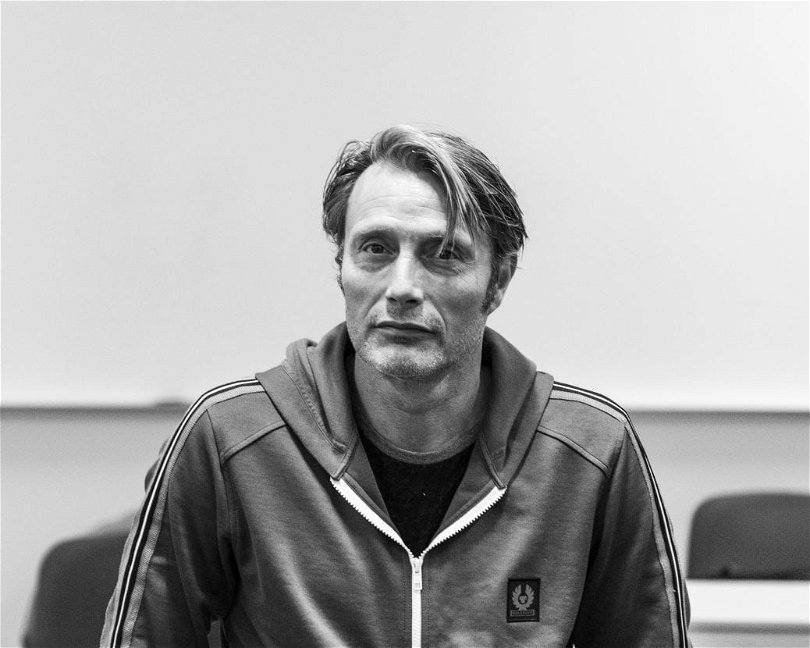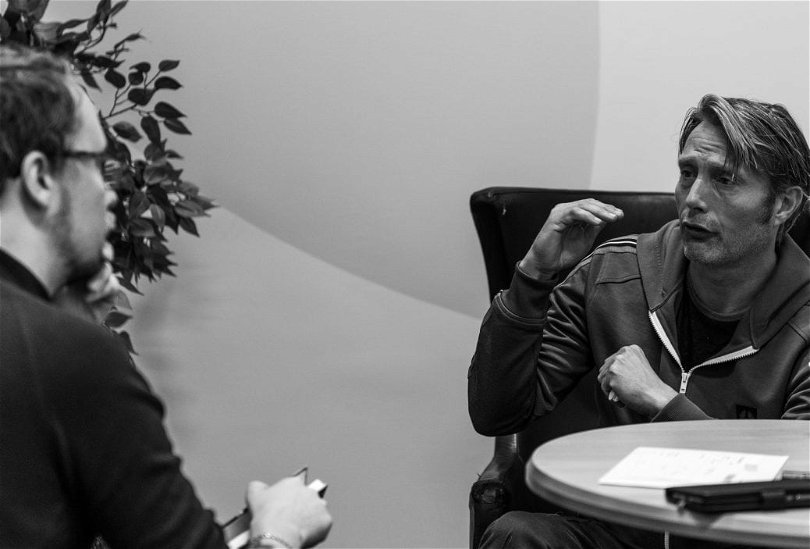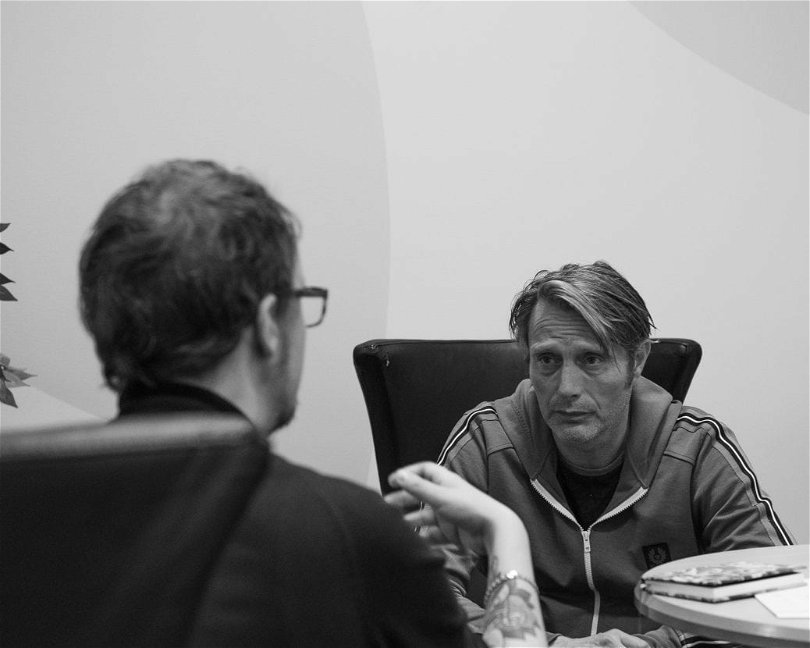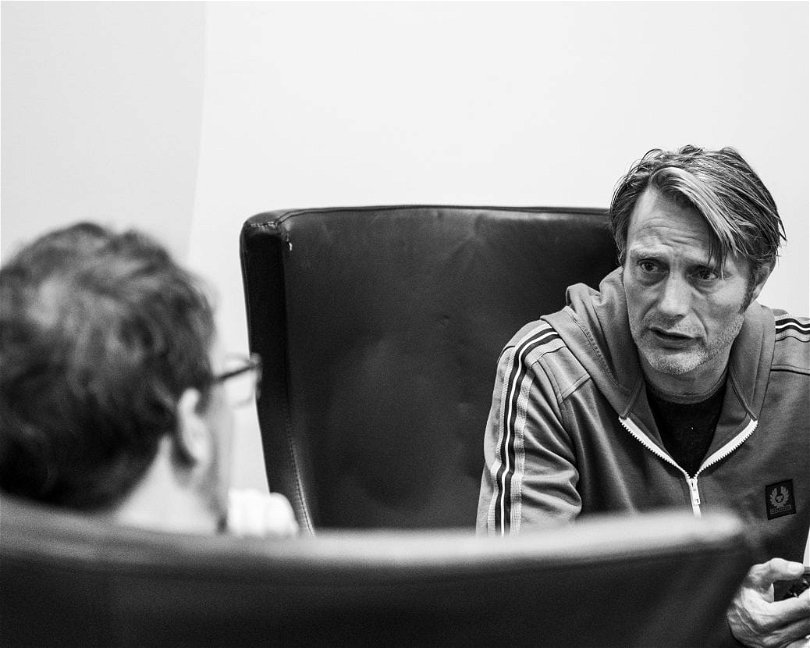
Exclusive interview with Mads Mikkelsen
From dancer to international film star – Mads Mikkelsen on his long and fascinating career.
He has been the face of Danish cinema since the Danish movie industries blooming in the mid 90’s. In the 21st century, he had his big international breakthrough when participating in three of the biggest franchises in history: Star Wars, Marvel’s Cinematic Universe, and James Bond. Filmtopp met Mads Mikkelsen for an exclusive interview about the actor's multifaceted career.

The Danish film star Mads Mikkelsen is at Comic-Con Stockholm. He has declined interviews with the press to be able to spend more times with his fans, but Filmtopp got an exclusive talk with the charismatic actor.
One thing that makes Mads Mikkelsen's career so fascinating is that he never had any big plans on becoming an actor. He started at the Ballet Academy in Gothenburg 1987, and 30 years later he has had leading roles in some of the world’s biggest movie franchises. What makes it even more odd is that the same can be said about his brother Lars Mikkelsen, who started his career as a street artist, to later shine in productions such as House of Cards and Sherlock.
– My journey started in the world of dancing, says Mads. I was a gymnast and later, by coincidence, became a dancer. After a while, I became more interested in the dramatic aspects of dance and decided to become an actor. My brother started from another angle. I taught him how to juggle with three balls. He became great at it and could soon do it with five. Then he began with a, quite crazy, street circus, and through that, he became interested in acting.
Between ’92 and ’96 Mad studied drama. On the year of his graduation, his debut- and breakthrough movie Pusher was released, a realistic drug drama directed by another debutant, Nicolas Winding Refn. Refn would after the acclaimed Pusher trilogy have successes with movies such as Drive and The Neon Demon.
– Nicolas got into film school as an editor but wanted to be a director. So, he had to decide whether he should stay in school as an editor or do Pusher, for which he had raised some money. I think he was the first ever to drop out of that school. It was so hard to get in.
If we go back to you and your brother, when you get these great roles, how do you tell each other about it? Is it hard?
– No, it’s fun! We never expected any of this when we started. I loved film and wanted to do something in Denmark that reminded me of what I’d seen in America and Russia. It was my dream, and luckily, I met Nicolas. My brother was in love with the theatre and wanted to be on the stage, battling the big classics. We never thought that we would go to Hollywood. We never really thought about becoming actors. So now, when it’s actually happening, that he gets to do House of Cards and I get to do films like Doctor Strange… It’s just fucking surreal!
”Vi pushed the limits for Danish cinema.”

There have been many highlights in Mads Mikkelsen’s career. Besides the already mentioned titles, there are three films nominated for an Academy Award in the Best Foreign Language Film section: The Hunt, After the Wedding and A Royal Affair. In addition to that, there are the critically acclaimed relationship drama Open Hearts, the war drama Flame & Citron and the already cult-declared Hannibal series. Mads talks about the most defining moments of his career.
– Pusher was defining since it was my first movie and I got to know Nicolas. The Hunt because Tomas Vinterberg, who was in a creative down, came back with this fantastic international success. Also my work with Anders Tomas Jensen. With the dark comedies Flickering Lights and The Green Butchers we pushed the limits for what was allowed in Danish cinema. We belonged to a generation known to be minimalistic, almost documentary, and then we did these crazy movies with these over-the-fucking-top characters and got away with it. Internationally speaking, the Bond movie was, of course, a door opener.
With an entrance in the world of minimalistic and naturalistic filmmaking, what’s your relationship to method acting?
– Method acting is wrapped in myths. You grow a beard and gain 20 kilos, or you stand in a video store for three months, as I did before shooting Bleeder. That's not method acting. It's research. Method acting is actually a rather boring technique, where you associate a certain emotion with a specific gesture. The second you touch a cup you shall recall a feeling. To do this, you need to drink a cup of coffee, 40 times, in the exact same way while you recall the emotion you want to connect to. It’s a system I’m no expert with, but it’s good for others.
For Mads Mikkelsen, it has always been about peeling off aspects from himself that is not consistent with the character he is portraying. He explains:
– It’s all about peeling off layers. I focus on the character and on the script, and I recognize everything, all the emotions. Sometimes they take up a big space within me, sometimes they don't. When the latter, I enhance the similarities between me and the character and peels off what's not consistent. It’s more about leaving stuff out.
In your upcoming movie, Arctic, you’re playing a man that has crash-landed on the Arctic and is forced to survive for months in the harsh landscape. You filmed it in Iceland, and I’ve heard that you didn’t prepare for the climate?
– Nobody expects they’ll be in a flight crash and be forced to survive. I didn’t want to know exactly how to do this or that. It’s something you’ll have to learn when you’re there.
”It’s about the character, not the accent.”

Between 2013 and 2015 Mads Mikkelsen starred in the TV-series ”Hannibal" in which we saw him as pop culture’s most famous cannibal, previously played by Sir Anthony Hopkins. Mads explains how tough it was to play such a well-known character.
– It was a challenge. We were very much aware of Hannibal Lecter being one of the most, if not the most, iconic horror character of them all, already worked out to perfection. But we also know that we were doing something completely different. Anthony Hopkins only had fourteen minutes of screen time. We had three seasons with thirteen one hour episodes. We could tell the story in a different tempo, hold our cards and work with another structure. That’s what got me interested. But it was hard.
– Everybody shared this idea of Hannibal as very British, with perfect English, but he is actually from Lithuania. He studied in France and Tokyo and later ended up in America. So, I added a touch of English to my own accent.
Is it hard to work with accents? In Hollywood, you’ve played villains with different European origins. Do you adjust your dialect accordingly?
– There are Swedish and Danish actors who are great at switching to American and British accents. On others, you can tell that they are only focusing on the right pronunciation and forget about their character. I know I would lose my acting skills if the accent took up too much focus. A few years ago I decided to simply do my best and lean the accent one way or another. If the character has a Russian sounding name, we'll get away with it. It’s all about the character, not the accent.
Throughout ”Hannibal” we get to see Dr. Hannibal prepare his incredible culinary (and barbaric) cooking. Mads tells us about the cooking tricks he picked up doing the series.
– We did so much great cooking! I learned a ton of tricks. Of course, I didn’t finish the meals and garnish them, but I did all the tricks. I flambéed it. I slung it. I chopped it. I’m great at chopping. No, I'm amazing at it! It was a lot of fun. The food was delicious. We had a fantastic cook that served us the food afterwards, and we could always choose between the real dish, of course without human flesh and organs, or a similar, kinder version. I always took the real thing, and it was great!
”They knew Lars von Trier wasn’t a Nazi.”

Although they both, in many ways, are the face of Danish cinema, Mads Mikkelsen has never worked with the Danish director Lars von Trier, who had his big breakthrough with the mid 90’s DOGMA movement. The DOGMA movies were centralized around ten rules, where the goal was to "force the truth out of the characters and the settings”. For example, by filming without additional lighting, in natural environments, without set pieces and props. I was curious about how Mads felt about an eventual collaboration with the famous director.
– Lars has done a lot of great things for the Danish cinema. He placed us on the map and was smart enough to come up with the DOGMA concept, but I’ve never been a fan of it. I mean, if you wanna do a budget movie, great, just do it. Don’t give me an excuse for why you don’t have any light settings. We didn’t have any extra lights in Pusher. We couldn’t afford it. The movie's energy must always have its focus on the story and the characters. If you need ten rules to remember that, sure, why not. It could be good for directors who focus too much on the technicalities, to get a reminder of what it’s all about. But Lars has done some fantastic movies. There’s no way around it. We owe him a lot.
Right after Lars Von Trier’s film ”Melancholia” was celebrated at Cannes Film Festival, the director became persona non grata. This because of a joke about Nazism, which started a long media hunt.
https://youtu.be/QpUqpLh0iRw
– I’m glad that Lars is still working after what happened in Cannes. It was a hysterical and terrible example of the world of political correctness becoming bestial. All the journalist in that room knew who he was. They knew how his humor was and that he had Jewish blood in his veins. That he wasn’t a Nazi. They knew, but couldn’t help themselves. They just wanted to see how much power they had, if they could break him. And they did. A disaster to witness. Lars is strange sometimes, he is. He can tell a joke that isn't funny, or you don’t understand it, but racist? No. Nazi? No. What happened was shameful. It was shameful that nobody stood up for him. It was shameful that this could happen, and it’s shameful that it keeps on happening. You’re from Sweden, you know what I mean.
But if he asks you, would you do a movie with him?
– That depends. We have hung out a few times, and I really like him in a certain way. But if we can communicate in work, that's a different matter. But I think we could.
You feel like a good combo.
– Yes, yes we do. Two small egos in a room, laughs Mads.
”I steal all the time!”

The big international breakthrough came when Mads played the blood crying Bond villain Le Chiffre in "Casino Royale”. Since then he’s been the architect of the Death Star in the Star Wars movie "Rogue One” and Benedict Cumberbatch’s kung-fu mastering nemesis in "Doctor Strange”. Considering the wide range of films he’s been working on, I had to ask Mads if he has ever nicked a souvenir.
– I steal all the time! In the Bond movie I stole Le Chiffre’s watch, and in Star Wars I stole something that I can’t tell you about, not yet. They would want it back. It’s unthinkable to be in a Star Wars movie and not take something. It must be done. You would be an idiot otherwise. Of course, I didn’t run off with Darth Vader’s helmet, but I took something with me, a reminder that I was there. That I was in a Star Wars film.
– It was a strange feeling when I arrived at the set the first time. I had just flown in from Denmark and entered this huge room with a 100-meter long table full of Stormtrooper helmets. It was surreal. And then it hit me, oh yeah, it was I who built the Death Star. Insane!
You’ve got four movies in the pipeline. Is there anyone that you want to push a little extra for?
– It’s strange to see them come now. I haven’t worked on a film for seven months, but I love them all. Arctic is in many ways a classic survival movie, but I also find it beautiful and quite radical. It’s heartbreaking. I’d also like to push for a movie that, funny enough, is called Polar. If you’re a fan of graphic novels, you’re familiar with the writer Victor Santos. Polar is his story about a hitman. We get a lot of hard-boiled in-your-face action. It was so much fun making it!